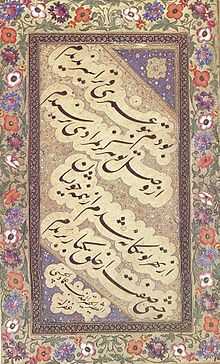Persian calligraphy
 |
| Calligraphy |
|---|
Persian Calligraphy (Persian: خوشنویسی ایرانی) is the calligraphy of Persian writing system. It has been one of the most revered arts throughout Persian history. It is considered to be one of the most notable examples of Persian culture.
History

The history of calligraphy in Iran dates back to the pre-Islam era. In Zoroastrianism beautiful and clear writings were always praised.
In the ancient Persia and in the different historic eras, languages such as “Ilami”, “Avestaaee”, “Pahlavi”, and “Farsi-e-Mianeh” were spoken. It is believed that ancient Persian script was invented by about 500-600 BC to provide monument inscriptions for the Achaemenid kings. These scripts consisted of horizontal, vertical, and diagonal nail-shaped letters and that is the reason in Persian it is called “Script of Nails” or “Khat-e-Mikhi”[2], or cuneiform as it is known in English.
Centuries later, other scripts such as “Avestaee” and “Pahlavits" were created. The Avestan alphabet or “Avestaaee” was created in the 3rd century CE for writing the hymns of Zarathustra. Avestan is an extinct Indo-Iranian language related to Old Persian and Sanskrit. Avestaaee script was related to the religious scripts of Zoroastrians’ holy book called “Avestaa” and unlike the nail script -that was carved on flat stones- Avestaaee script was written with a feather pen, usually on animal-skin pages. It is surprising that this script has similarities with Arabic scripts such as “Sols” and “Naskh” that centuries later were invented. However, unlike these scripts, letters in Avestaaee were not connected to each other to form a word but they just were written separately next to each other (similar to Latin scripts). However it wrote from right to left [2].
History of Nas’taliq




After initiation of Islam in the 7 th century, Persians adapted the Arabic alphabet to Persian and developed the contemporary Persian alphabet. Arabic alphabet has 28 characters and Iranians added another four letters in it to arrive at existing 32 Persian letters [2]. Around one thousand years ago, Ibn Muqlah (in Persian: ابن مقله بيضاوی شيرازی) and his brother created six genres of Iranian calligraphy, namely "Tahqiq", "Reyhan", "Sols", "Naskh", "Toqi" and "Reqa". These genres were common for four centuries in Persia. In 7th century (Hijri calendar), "Hassan Farsi Kateb" combined "Naskh" and "Reqah" styles and invented a new genre of Persian calligraphy, named "Ta'liq". Eventually in the 14th century, "Mir Ali Tabrizi" combined two major scripts of his time i.e. Naskh and Taliq and created the most attractive Persian Calligraphy style, "Nas’taliq"[2]. In past 500 years Iranian calligraphy called Nastaʿlīq Nastaʿlīq (also anglicized as Nastaleeq; in Persian: نستعلیق nastaʿlīq) is one of the main script styles used in writing the Perso-Arabic script, and traditionally the predominant style in Persian calligraphy.
Why Nas’taliq is different
It is really important to note that unlike its ancestors, Nas’taliq follows natural curves. In other words, unlike Arabic scripts that follow logical/geometrical designs, Nas’taliq follows the nature and natural curves. There are a lot of resemblances found between the curves used in Nas’taliq and natural curves and a few examples are shown here. It is interesting that it may not be the preliminary intention of Mir-Ali or the others to write the letters in such a form that they look like natural curves; but rather later these similarities have been found. Therefore, it shows that it is because of the initial spirit of Nas’taliq and its tendency toward nature that it looks so intimate and beautiful. But it is harder to read than Naskh.
History of cursive Nas'taliq
Morteza Gholi Khan Shamlou and Mohammad Shafi Heravi created a new genre called cursive Nastaʿlīq Shekasteh Nastaʿlīq in the 17 th century. Almost a century later, a prominent artist named Abdol-Majid Taleqani brought this genre to its highest level. This calligraphy style is based on the same rules as Nas’taliq, but it provides more flexible movements. It is a little more stretched and curved. Among contemporary calligraphers in this style, “YadollahKaboli” definitely ranks in the most prominent place.
Contemporary Persian calligraphy
In 1950, Iran's Association of Calligraphers was founded by Hossein Mirkhani, Ali Akbar Kaveh, Ebrahim Bouzari, Hassan Mirkhani and Mehdi Baiani. In Afghanistan, Azizuddin Vakili published a book entitled "Calligraphy during last two centuries in Afghanistan" (1964).
Modernist movement
Zendeh Roudi, Jalil Rasouli, Parviz Tanavoli, and Masih Zad use Persian calligraphy and Rumi poetry in dress designing.
Genres
- Nasta'liq script
- Shekasteh Nastaʿlīq (Cursive Nasta'liq)
- Naghashi-khat (Painting-Calligraphy combined)
Most notable figures
- Mirza Ahmad Neyrizi
- Mir Ali Tabrizi
- Mir Emad
- Mirza Buzurg-i-Nuri
- Mishkín-Qalam
See also
- Calligraphy
- Islamic calligraphy
- List of Persian calligraphers
- Arabic inscriptions in Persia